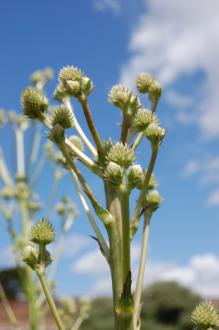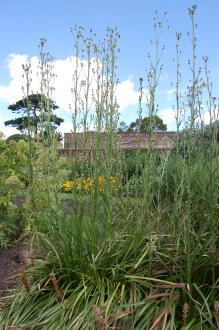
Eryngium yuccifolium Flower (30/06/2012, Kew Gardens, London)
Position: Full sun
Flowering period: Summer to early autumn
Soil: Moist/ dryish, well drained
Eventual Height: 1.8m
Eventual Spread: 1m
Hardiness: 3a -9b
Family: Apiaceae
Eryngium yuccifolium is a tall growing, evergreen, herbaceous perennial. Its green/ blue leaves are linear with spiny margins and a sharp tip, up to 1m long and 3cm broad. Its green/ white flowers are up to 4mm across and are produced in dense apical umbles which are up to 4cm across. Its fruits retain the shape of the flowering umble throughout the winter months before they decompose, they turn brown as they are mature, each fruit contains one 6mm long seed. Its root is a tap root and dislikes disturbance.
Eryngium yuccifolium, commonly known as Button Snakeroot, Rattlesnake Master and Button Eryngo, , is native to central and eastern North America. In its native habitat it grows in tall grass prairies. Its common names refer to the native Americans use of this plant as an antidote for Rattlesnake venom.

Eryngium yuccifolium (30/06/2012, Kew Gardens, London)
The etymological root of the binomial name Eryngium is derived from the Greek hruggion, a name given by Theophrastus for ”a spiny leaved plant’. Yuccifolium is derived from the Latin folium meaning ‘leaf’ and Yucca, in reference to this plant’s leaf being similar that of the Yucca genus.
The landscape architect may find Eryngium yuccifolium useful in prairie type planting schemes. The flower heads of this plant provide interest throughout the winter months. Once established this plant is drought tolerant.
Ecologically, E. yuccifolium is attractive to pollinating insects.
The Royal Horticultural Society has given E. yuccifolium their prestigious Award of Garden Merit in 1993.
E. yuccifolium prefers moist/ dryish, well-drained soils. It tolerates most pH of soil. It dislikes water logging.
Eryngium yuccifolium requires little maintenance. Large clumps may be divided in spring.

